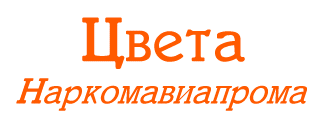
The NKAP Templates Explained

The NKAP Templates Explained
The NKAP was responsible during the Great Patriotic
War for making recommendations and policies on the painting of military
aircraft. Likewise, when new aero lacquers were introduced, it was at the
behest of this Ministry, and under their guidance. Thus it came to be that
during the War a number of suggested camouflage schemes were mooted by
the NKAP.
These suggested schemes, in fact, were just that--
they were recommendations. They were not requirements in any sense of the
word, neither was their use enforced by the Government at any time. The
specific patterns suggested by the NKAP were in the form of a three-view
'template' showing the desired application; they have come, then, to be
known as the "NKAP Templates".
Fighter Aviation
An NKAP Template was issued in 1943 for VVS fighter
aircraft. This Template accompanied the introduction into manufacture of
several new aero lacquer colors, these all of the "AMT" variety of aviation
finishes. The new color scheme suggested for fighter aviation consisted
of a two-color disruptive application of AMT-12 Dark Grey over AMT-11 Grey-Blue.
The Template was intended to apply to all VVS fighters, regardless of type.
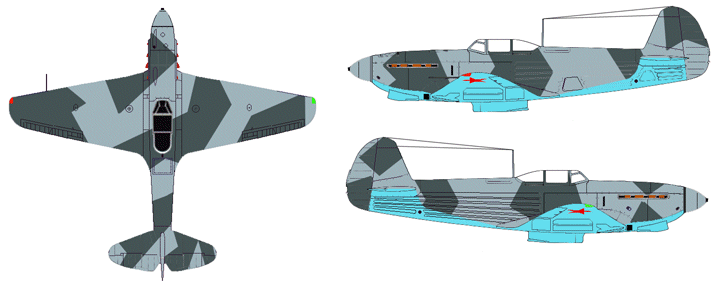
Certainly after the beginning of 1944, the use of
the new grey colors as stipulated by the NKAP become almost universal at
factories manufacturing VVS fighters. However, there are no photographs
that show any VVS fighter wearing such an angular pattern application.
Indeed, this scheme is anathema to Soviet camouflage in general, which
tended to be organic and rounded in execution; such angularity would be
completely out of character. As such, this pattern was never painted by
any of the factories to match this Template.
However, the basic planform of the scheme was put
into use; indeed, widespread use. These are usually referred to as 'NKAP
schemes', and they are composed of many of the basic features on this Template.
Grib's famous Yak-9D "22" is a classic example of an actual VVS scheme
based on the NKAP fighter Template, and in the realities of production
these applications tended to look like this example.
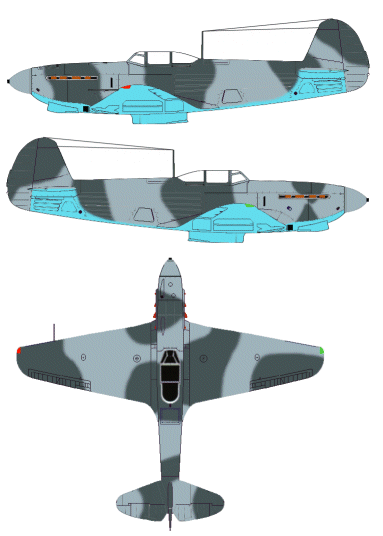
The classic 'hourglass' feature on the starboard
nose is evident, as is a softer and simplified permutation of the upper
surface pattern. Hard-edged color demarcations were almost never seen in
the 1944-45 period (a la the Template), and neither were straight
edges.
Two further classic variations are show below.

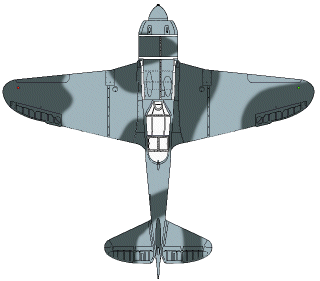
In the Yak-3 programme (above), the 'tongue' feature
of dark color on the starboard fin was quite typical, as were off-set 'hourglass'
features. The La-7 (lower) often demonstrated a considerably revised upper
surface pattern, but more typical side views.
In all, it should be stressed that there was no
real "standard" for these patterns. Simply, many factories responded by
incorporating some of the NKAP's ideas into the schemes they applied to
their fighter products, and by no means whatever were these the
only camouflage patterns of the 1944-45 period in AMT-12/-11 colors.
The Shturmovik
No fewer than three Templates were issued for Il-2
camouflage by the NKAP during the GPW. Two of these appeared in 1943, and
the last in late 1944. The 1944 Template was for a two-color AMT-12/-11
camouflage very similar to the Fighter scheme, and this was completely
ignored by the various Il-2 factories. However, the 1943 Templates were
both 3-color camouflage schemes using the finishes AMT-4, AMT-12, and AMT-1.
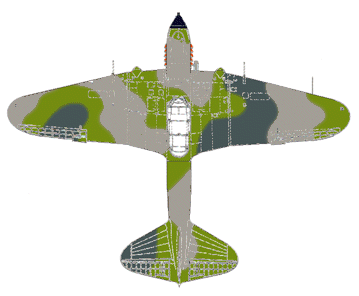


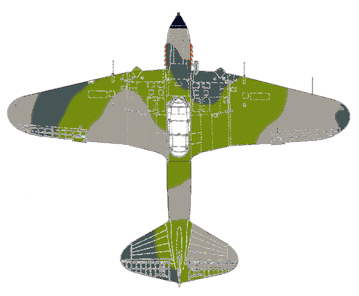


The scale of the employment of these camouflage
schemes, and using these colors, is a matter not yet resolved satisfactorily.
To date, very few photographs exist of Il-2s painted in this way;
I recently calculated that these examples account for 1.5% of the total
number of known photos. There are examples of these NKAP Template schemes
on both straight-winged--and more typically--on swept-wing (arrow)
two-seat Il-2s, but none as yet on single-seat machines, as one would certainly
suspect (given the timing). However, it should be noted also that this
scheme can be difficult to detect on the poorer Soviet film types (basically,
journalist type films), and so the total number of representative examples
might possibly be higher that the proportion we know today. On the other
hand, many Il-2 schemes are known, and it is logical (as well) that these
NKAP jobs might have represented rather an exception than the rule.